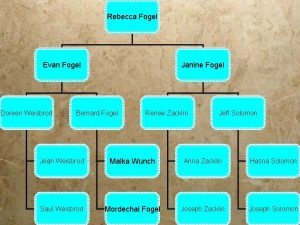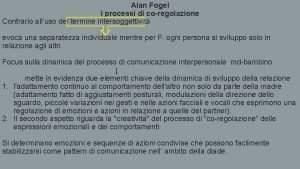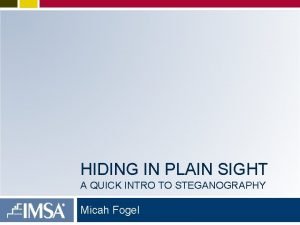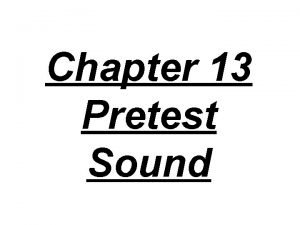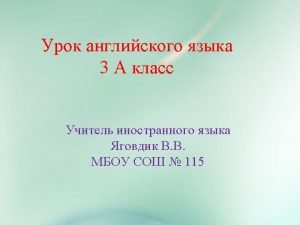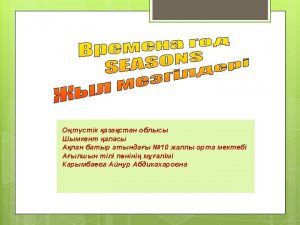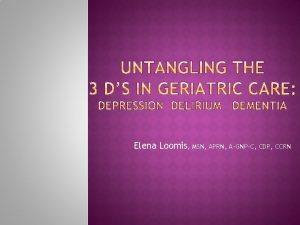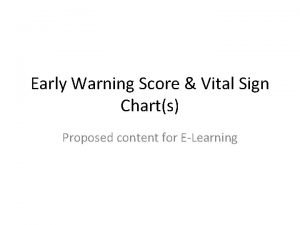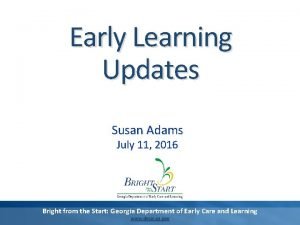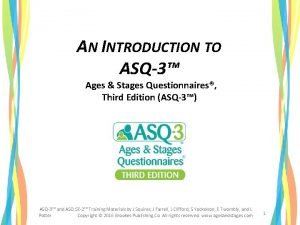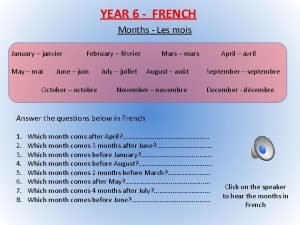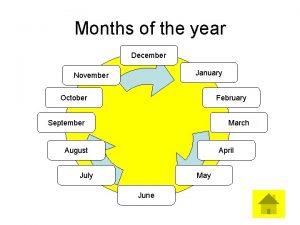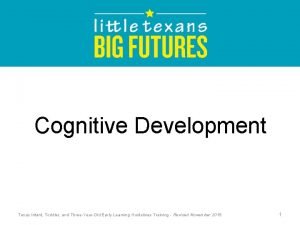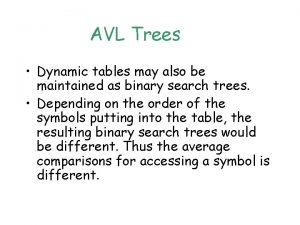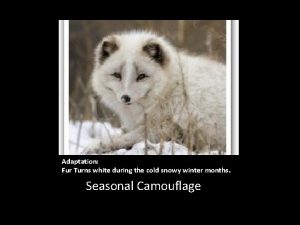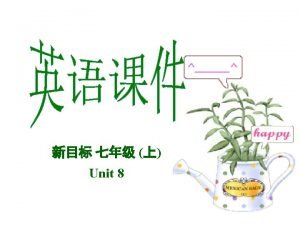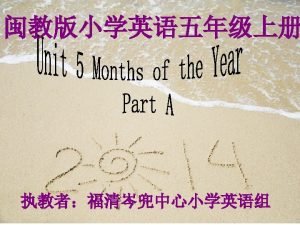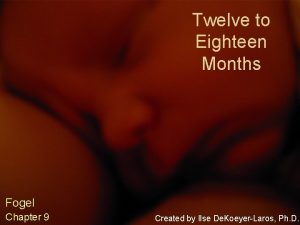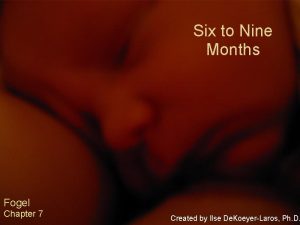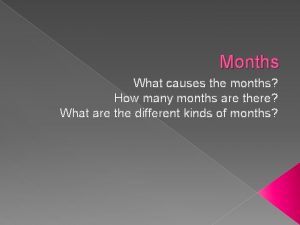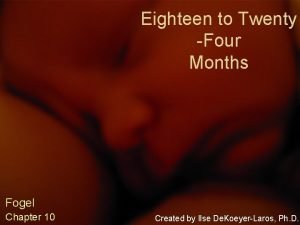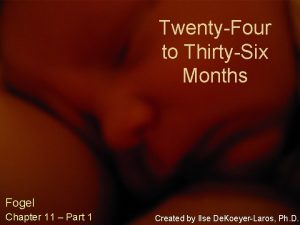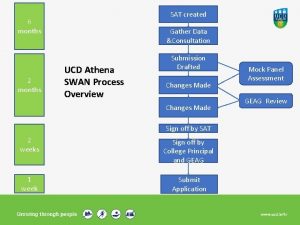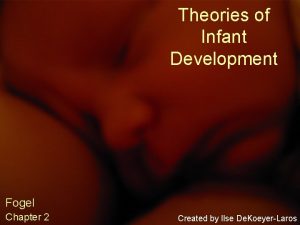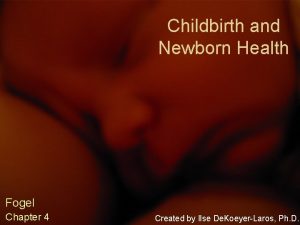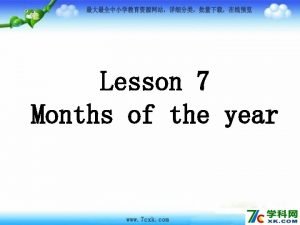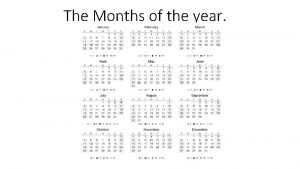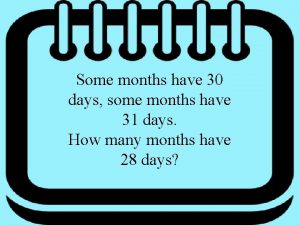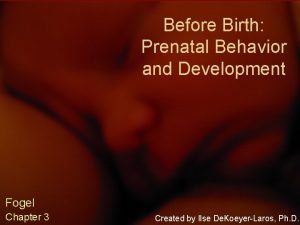The First Two Months Fogel Chapter 5 Created








































































- Slides: 72

The First Two Months Fogel Chapter 5 Created by Ilse De. Koeyer-Laros, Ph. D.

Overview Chapter 5 • • • Physical and Motor Development Perceptual Development Cognitive Development Emotional Development Family and Society Experiential Exercises Co-regulating with Baby

Physical and Motor Development Newborn States The fetal states of rest & activity develop into sleeping & waking states • at 32 weeks gestation: REM & non-REM • by 38 weeks: several other sleep states • newborns sleep about 17 hours per day, throughout the day and night • by 3 or 4 months, infants sleep more at night than during the day, but night wakings are common in infancy and early childhood

Physical and Motor Development Newborn States State Description Quiet sleep Respiration is regular; eyes are closed and not moving; (NREM) the baby is relatively motionless Active sleep (REM) Muscles more tense; eyes may be still or display REMs; breathing is irregular; spontaneous rhythmic startles, sucks, and body movements Drowsiness Opening and closing of the eyes; increased activity; more rapid and regular breathing; occasional smiling Quiet alert Eyes open, scanning the environment; body is still; respiration is more rapid than in sleep Active alert Awake, body and limb movements, less focused than in the quiet alert state Crying Elevated activity and respiration rate; cry vocalization; facial expression of distress

Physical and Motor Development Waking States Newborns have two basic modes of response to stimulation: orienting & defense – orienting – a heightened alertness that includes behavioral localization toward the source of the stimulation (a head turn to the source of a sound) – defense – a behavioral action that involves withdrawal from the source of stimulation

Physical and Motor Development Waking States Newborns will orient to stimuli of moderate intensity and complexity soft talking, moderate light levels, and holding & rocking can enhance alertness

Physical and Motor Development Crying State • Crying is an organized rhythmic activity – there are different cries with different body responses and cry sounds • The frequency increases between birth and 2 months – then, it decreases – similar in many cultures with different patterns of infant care & response to crying – infants cry more when parents are slower to respond

Physical and Motor Development Crying State Colic is crying in which 1. the infant cries at least 3 hours a day, on at least 3 days per week, for at least 3 successive weeks 2. the parents find the crying very intense 3. the infant is otherwise normal; and 4. the infant is relatively unresponsive to soothing & feeding

Physical and Motor Development Crying State • What causes colic? – unknown – not caused by digestive problems, sympathetic nervous system arousal, or cortisol levels • Factors related to colic – mothers who were highly stressed during pregnancy had higher chances of having a colicky baby – colicky infants are more likely to have sleep problems & to be inattentive, emotionally reactive, and sensitive to touch, food, and other stimulation at 3 & 8 years

Physical and Motor Development The Effects of Crying on Adults • Adults perceive crying as an index of distress & they try to figure out the source – nonparents are as responsive as parents – levels of arousal & responsiveness are equal for men & women • Child abusers show greater arousal & more annoyance at cries than nonabusers

Physical and Motor Development Soothing Infants • nonnutritive sucking (NNS) immediately soothes • swaddling reduces motor movement & startles; keeps the infant calm for long periods • daily massage enhances alertness, sleep, growth & reduces stress and crying • rocking can calm or put infants to sleep • continuous sound can be calming, esp. when moderately loud & of low frequency (e. g. , singing lullabies, humming)

Newborn States Newborn state is important 1. the body needs periods of tranquility and rest to consolidate resources for growth 2. attention to the environment depends on a stress-free state of quiet alertness 3. state regulates the types of interactions newborns have with their adult caregivers Picture from: flickr. com

www. babyzone. com Reflexes – semiautomatic behaviors, triggered only by specific elicitors – look about the same every time they occur – have to run their course once triggered See examples of reflexes on You. Tube, such as the sucking reflex at www. youtube. com/watch? v=KIgzq. Ra. YJsg http: //health. allrefer. com/health/infantile-reflexes-moro-reflex. html

Reflexes Purposes • Primitive forms of orienting behavior – e. g. , rooting, sucking, and grasping • Primitive defensive reactions – e. g. , the Moro reflex, reaction to a cloth on the face • Elementary coordinations for later adaptive & voluntary movements – e. g. , stepping, crawling, and swimmer’s reflexes • No clear function – e. g. , the Babinski reflex – although the lack of a Babinski response may indicate neurological disorder Picture from: www. susheewa. com/blog/? p=866

Physical and Motor Development Reflexes • Reflexes are highly variable within & between infants – depends on individual differences, age, time since last feeding & number of attempts to evoke the reflex • Many disappear by about 6 months – brain developments and other factors play a role (e. g. , weight & muscle strength in the stepping reflex)

Physical and Motor Development Reflexes In sum, – newborn reflexes are extremely important for orienting the infant to the environment & for protecting the infant from harm – movements related to reflexes are not simply discharges in the brain, but depend on muscle movement, weight, state, illness & many other factors – reflexes play a role in the active development of the muscles, leading to increased strength & coordination

Physical and Motor Development Growth Asynchronous growth: different parts of the body grow at different rates & at different times

Physical and Motor Development Sucking is a reflex that is crucial for survival – it changes over time & becomes more voluntary

Physical and Motor Development Growth The newborn’s arms & hands are among the least controlled parts of the body – arm & hand movements seem uncoordinated but detailed video analyses show that they occur in meaningful patterns

Physical and Motor Development The Brain Neuroscience – the study of the brain & nervous system as it relates to psychological & behavioral functions such as moving, thinking, and feeling

Brain structures and functions Major areas of the brain – brain stem – limbic system – cortex

Brain structures and functions The prefrontal cortex is least developed in infancy – connects limbic & cortical areas – responsible for social & emotional regulation – involves thinking, reasoning, and judging Picture from: www. cast. org

Brain structures and functions Most developed in infancy – brain stem – controls autonomic functions such as breathing and heart rate – limbic system – processes emotions and memories & some body functions • the important structures are the hippocampus, amygdala, hypothalamus, and pituitary gland

Brain structures and functions The Limbic System • Hippocampus – important in the formation of memories for events & sequences (autobiographical memory) – during the first 3 years, the hippocampus develops links with the language & cognition areas of the cortex • Amygdala – plays a role in the formation of emotional memories, especially those around fear & safety Picture from: homepage. psy. utexas. edu

Brain structures and functions The Limbic System • Hypothalamus – links the brain to the endocrine systems of the body via the pituitary gland – regulates stress, body temperature, hunger, thirst, and day-night rhythms • The pituitary gland produces hormones – for stress regulation, maintenance of body state, sexual activity, milk production in nursing mothers, & cell growth Picture from: www. crnasomeday. com/anatpages/pituitary. htm

Physical and Motor Development Two Hemispheres • Right hemisphere – processes the majority of social & emotional activity – major development during the first 2 years of life (emotion regulation, attachments) • Left hemisphere – more specialized for thinking & language – develops more rapidly after the first 2 years

Fetal and infant brain development A critical period The period from the 5 th gestational month through the age of 3 -4 years is a critical period for the development of the human brain – To understand why, we need to look at the structure of neurons – information storage & transfer cells

Fetal and infant brain development A critical period The brain develops by four basic processes: 1. New cells are created via mitosis during the prenatal period • most development after this occurs by making cell connections & by pruning of unused neurons 2. The brain becomes more efficient • glial cells guide growth & migration of neurons (prenatally) • myelination increases the speed of conduction along the axon (mostly right before & after birth)

Fetal and infant brain development A critical period 3. Synaptogenesis – cells grow more dendrites & axon terminals & make more synaptic connections & neurotransmitters

Fetal and infant brain development A critical period 4. The role of experience • experience expectant pathways await specific environmental input • e. g. , pain elicits crying • experience dependent pathways are based on unique experiences • those that are used most become strengthened; those that are used the least eventually die

Optimal & non-optimal brain development Neural plasticity – the ability of the brain & nervous system to seek novelty, learn, and remember by continuing to alter the patterns of connections between neurons – intact brains retain plasticity throughout life – impairments in social & linguistic skills, along with brain abnormalities, develop in infants reared in orphanages or infants not exposed to appropriate language

Optimal & non-optimal brain development Each baby in the first two years of life comes to assess the social world as either a safe or a threatening place

Optimal & non-optimal brain development Neuroception – nonconscious evaluation of safety or threat, by the nervous system and not the conscious mind (Porges, 2004)

Optimal & non-optimal brain development Neuroception is regulated by – Sympathetic & parasympathetic nervous systems • Sympathetic nervous system – prepares the body for action • Parasympathetic nervous system – allows the body to relax, slow down, process information, engage socially, learn & grow; the vagus nerve is most responsible for neuroception – The HPA-axis

The HPA-axis When stress occurs: Hypothalamus: CRH Pituitary gland: ACTH Adrenal glands: Cortisol

Optimal & non-optimal brain development • Cortisol prepares the body for action in response to stress – increases blood sugar needed for action – feeds back into the limbic system where it heightens the formation of memories related to the stressful event • If stress is persistent, cortisol is overproduced – prolonged activation of cortisol suppresses the immune system & physical growth – too much stress leads to a tendency to feel fear and threat in the future & can lead to post traumatic stress disorder (PTSD)

Optimal & non-optimal brain development

Optimal & non-optimal brain development In sum, the first 3 years of life are critical for brain development – for the development of the limbic & prefrontal parts of the right brain, which is dependent on the quality of love, emotional sharing, & social engagement received & perceived – not for cortical & left-brain processes like reading, math, thinking, or musical ability

Optimal & non-optimal brain development It is more important for infant brain development to spend quality one-on-one and family time than letting the baby play for long periods with expensive toys, or listen to Mozart, or watch baby TV programs

Perceptual Development • Ecological perception – experience that relies on direct perception through the senses – the senses form the basic ways in which we are connected to the environment • Newborns have the ability to see, hear, taste, smell, and feel – although not as focused or discriminating as adults can

Perceptual Development Newborn visual acuity & visual processing are poor but improve rapidly – visual acuity is only 20/500 on average, due to an immature nervous system – the newborn’s visual world is rather blurry, but the infant can see colors – as a result of experience-dependent brain development, visual acuity improves to nearly 20/20 by 6 months

Perceptual Development • Oculomotor skills – movements that the eye makes to – bring objects into focus – follow moving objects – adjust for objects at different distances • Newborns’ tracking of moving objects is jerky, and they only follow slowly moving objects – at 6 -8 weeks, following becomes more adultlike

Perceptual Development Scanning – the eye traces a path across a visual stimulus in small, rapid movements

Perceptual Development • Oculomotor control adjusts the eyes to see objects at different distances • Depth perception – the ability to judge the relative distances between two objects & determine whether objects are close or far – The ability to compare the two retinal images (and therefore to see distance) emerges slowly between 3 & 6 months

Perceptual Development • Can newborns see patterns? – Studies show that newborns can detect differences between visual images & seem to prefer some images more than others • Newborns prefer – objects with clearly marked edges & outlines – circular patterns over straight lines – the external contours of a figure, especially if the edges are sharp

Perceptual Development Newborns have perceptual preferences that are likely to bring them into contact with things that enhance their survival – infants prefer faces over other objects – 1 -day-old infants change their sucking response to see a picture of their mother’s face rather than the face of an unfamiliar female – but not when the mother is shown wearing a scarf – newborns prefer to look at faces judged by adults to be more attractive – they also prefer faces in which the other person’s gaze is directed toward the infant rather than averted

Auditory Perception • The auditory system is more mature at birth than the visual system • Auditory sensitivity (sensitivity to sounds) involves loudness & pitch – newborns can hear sounds of 40 -60 d. B but only sounds from 50 -70 d. B can awaken them – they prefer sounds in the middle range; higher pitch over lower pitch; sounds made up of more than one note; and melodic sequences over a jumble of unrelated notes

Auditory Perception The most common source of such sounds is an adult female voice, talking or singing – newborns prefer to listen to a song or story that their mothers had sung or read aloud 2 weeks prior to birth over an unfamiliar song or story – newborns seem to prefer heartbeat sounds similar to those they must have heard prenatally – infants can distinguish the voice of their own mother from the voices of other women.

Auditory Perception How do newborns distinguish speech sounds from different people? – They may detect overall patterns of rhythm & pitch that differentiate one person from another – They may be able to hear differences among syllables that give them cues about a speaker’s uniqueness • By 1 month, they distinguish two very closely related speech sounds (e. g. , “p” and “b”) and by 2 months, they recognize vowel differences

Taste Newborns seem to distinguish the four basic tastes: sweet, salty, sour, and bitter – They show different responses to these four tastes – Sweet fluids seem to relax (see pictures) – Sour, bitter & salty tastes elicit negative responses

Smell • Newborns can differentiate between odors (incl. vinegar, licorice, & alcohol) – In response to unpleasant odors, they make faces of disgust and turn away • They may recognize their mothers by odor – Newborns turn their heads more to a pad containing their mother’s breast milk than to one containing another woman’s milk – Breast-fed infants can also recognize their mother’s underarm odor & perfume & they prefer the smell of any breast milk over other types of smells

Touch Many reflexes are stimulated by touch & newborns show changes in behavior & heart rate in response to tactile stimulation – They adjust hand & mouth movements when feeling soft vs. hard objects, or smooth vs. textured objects – They visually recognize an object they had previously touched, but not the other way around – In response to medical procedures (e. g. , injections, circumcision), infants show increased distress and may exhibit sleep disturbances

Perceptual Development In sum, – newborns perceive with all their senses and their sensitivity improves rapidly over the first few weeks and months, due to brain development & experience – many forms of stimulation have no particular meaning for the infant but others are meaningful (e. g. , recognizing mom, crying in response to pain)

Cognitive Development Newborns possess a number of ways to process information that are referred to as cognition – including learning & memory, orienting & habituation, and imitation

Cognitive Development • Classical conditioning – possible when the unconditioned stimulus (UCS) evokes a rewarding natural response, such as a sweet taste • Operant conditioning – once infants learn the connection between their behavior & a reinforcement, they can signal their preferences, using sucking rate or head turn – newborns can remember (e. g. , a word repeated by mom) for appr. 24 hours & they prefer familiarity

Cognitive Development • Habituation is the decline in strength of responding after repeating the same stimulus; dishabituation is renewed interest • Newborns’ motor and heart rate responses have been found to habituate to auditory stimuli, visual stimuli, and tactile stimuli • Habituation can also be shown in premature newborns and even in infants born without a brain cortex (anencephalic)

Newborn Imitation Meltzoff & Moore (1977) showed that 12 - to 21 day-old infants could match tongue protrusion, lip protrusion, mouth opening, hand opening, and hand closing

Newborn Imitation • These findings have been replicated – One study showed that newborns also matched moving objects – One study found imitation of surprise, happy, and sad facial expressions • Other studies failed to replicate these findings – babies show a wide variety of gestures following the model – there are wide individual differences

Newborn Imitation Newborn imitation may be a way of relating to people – Infants who imitated more at birth gazed away from their mothers less at 3 months – Newborns’ imitation of tongue protrusion showed a different pattern of heart rate change compared to when they initiated the same movement (as if to get a response) – 6 -week-old infants spontaneously reproduced the imitative response they had learned 24 hours earlier when seeing the adult model

Newborn Self-Awareness: The Emergent Self Evidence for early self-awareness comes from studies that show – Newborn imitation (distinguishing own movements from the movements of others) – Differential rooting (more when touched by someone else than by touching self) – Differential crying (more when they hear tape recordings of other infants’ cries)

Newborn Self-Awareness: The Emergent Self The emergent self is the sense of self-sameness over time in behavior, feelings, and states of arousal

Cognitive Development In sum, – newborn cognition is limited to some simple forms of learning, memory, habituation, imitation, and selfawareness – early learning and memory are fundamental to survival • recognition of maternal sounds and smells • learning to orient to sweet fluids & milk • learning to avoid noxious smells & tastes – newborns prefer familiar sights, sounds, tastes, & feelings, and do not like to be stressed or challenged

Emotional Development Newborns can feel distress, contentment, disgust, interest, & surprise – newborns ‘savor’ sweet liquids – they cry, thrash about, stiffen their bodies when distressed – when attending to faces, social interaction, & moving objects, they may show expressions of interest & surprise

Emotional Development • Some expressions (e. g. , smiling) do not occur with any clear link to the situation • Emotional development depends in part on how newborn forms of expression are interpreted by adults

Family and Society Adults and infants have mutually complementary communications that get their interaction started and set the stage for later emotional ties – Attachment – the maintenance of mutual proximity over time – Bonding – skin-to-skin contact immediately after birth, between mother and infant Picture from: raisingchildren. net. au

Family and Society • Mothers & fathers explore the newborn’s body in a patterned way when given the opportunity – apparently important for survival • However, there is no conclusive evidence linking these first few minutes of contact with later attachment security – When there is no immediate post-birth contact, lasting attachments can still be formed Picture from: www. smh. com. au

Family and Society There is also a social-psychological component that may form the basis of later interpersonal communication and attachment – early feeding patterns (suck-pause, jiggle-stop, suckpause, jiggle-stop, etc. ) precede later social discourse – animated adult faces & brightly colored objects prolong periods of alertness – the duration of parent-infant face-to-face play & infant attention gradually increases over the first 2 months

Family and Society • Studies of large-scale national samples show that fathers spend 20 -35% as much time as mothers in direct infant care • Men’s ability to participate in parenting tasks depends on the amount of social support they receive, particularly from their partners • The more involved fathers are, the more involved they become

Family and Society • Father-infant and mother-infant interaction can be enhanced by specific interventions to orient parents to their newborns – E. g. , 12 -week-old infants whose fathers had been trained in massage & bathing were more likely to interact with their fathers & fathers were more likely to be involved with their infants than nontrained fathers • Parenting occurs within a family system Picture from: www. childways. co. uk

Family and Society • First-time parents appear more hesitant with their babies, but this difference disappears after several months • Firstborn newborns receive more caregiving interaction

Experiential Exercises: Sucking • Sucking is the first mouth movement that we master –later we build on our infant sucking ability as we learn to control thousands of other mouth & face movements – Lie on your right side in a fetal position, and place your hands close to your mouth – Gently protrude your lips & tongue and experiment… – Now try sucking movements… • Many people experience a deep relaxation of the face after doing this lesson. What was your experience?

Experiential Exercises: Somatic Awareness of the Hands • • Sit in a chair & close your eyes – become aware of your body in the chair Now, notice your hands – what position are they in? How do they feel? – Slowly move your hands… – Now, slowly curl & uncurl your right hand – then the left – Let your hands explore your body, clothes, the chair, & each other – Open your eyes and look at your hands as if you’ve never seen them before
 Dr bernard fogel
Dr bernard fogel Alan fogel
Alan fogel Sap trade management
Sap trade management Trimethius
Trimethius When was the first phone created
When was the first phone created The two terms of comparison in the first two quatrains are
The two terms of comparison in the first two quatrains are What phenomenon is created by two tuning forks
What phenomenon is created by two tuning forks When god created woman he gave her not 2
When god created woman he gave her not 2 Hát kết hợp bộ gõ cơ thể
Hát kết hợp bộ gõ cơ thể Ng-html
Ng-html Bổ thể
Bổ thể Tỉ lệ cơ thể trẻ em
Tỉ lệ cơ thể trẻ em Voi kéo gỗ như thế nào
Voi kéo gỗ như thế nào Chụp tư thế worms-breton
Chụp tư thế worms-breton Hát lên người ơi
Hát lên người ơi Các môn thể thao bắt đầu bằng từ đua
Các môn thể thao bắt đầu bằng từ đua Thế nào là hệ số cao nhất
Thế nào là hệ số cao nhất Các châu lục và đại dương trên thế giới
Các châu lục và đại dương trên thế giới Công thức tính thế năng
Công thức tính thế năng Trời xanh đây là của chúng ta thể thơ
Trời xanh đây là của chúng ta thể thơ Cách giải mật thư tọa độ
Cách giải mật thư tọa độ 101012 bằng
101012 bằng Phản ứng thế ankan
Phản ứng thế ankan Các châu lục và đại dương trên thế giới
Các châu lục và đại dương trên thế giới Thể thơ truyền thống
Thể thơ truyền thống Quá trình desamine hóa có thể tạo ra
Quá trình desamine hóa có thể tạo ra Một số thể thơ truyền thống
Một số thể thơ truyền thống Cái miệng xinh xinh thế chỉ nói điều hay thôi
Cái miệng xinh xinh thế chỉ nói điều hay thôi Vẽ hình chiếu vuông góc của vật thể sau
Vẽ hình chiếu vuông góc của vật thể sau Biện pháp chống mỏi cơ
Biện pháp chống mỏi cơ đặc điểm cơ thể của người tối cổ
đặc điểm cơ thể của người tối cổ Thế nào là giọng cùng tên?
Thế nào là giọng cùng tên? Vẽ hình chiếu đứng bằng cạnh của vật thể
Vẽ hình chiếu đứng bằng cạnh của vật thể Vẽ hình chiếu vuông góc của vật thể sau
Vẽ hình chiếu vuông góc của vật thể sau Thẻ vin
Thẻ vin đại từ thay thế
đại từ thay thế điện thế nghỉ
điện thế nghỉ Tư thế ngồi viết
Tư thế ngồi viết Diễn thế sinh thái là
Diễn thế sinh thái là Dot
Dot Các số nguyên tố là gì
Các số nguyên tố là gì Tư thế ngồi viết
Tư thế ngồi viết Lời thề hippocrates
Lời thề hippocrates Thiếu nhi thế giới liên hoan
Thiếu nhi thế giới liên hoan ưu thế lai là gì
ưu thế lai là gì Hổ đẻ mỗi lứa mấy con
Hổ đẻ mỗi lứa mấy con Khi nào hổ mẹ dạy hổ con săn mồi
Khi nào hổ mẹ dạy hổ con săn mồi Hệ hô hấp
Hệ hô hấp Từ ngữ thể hiện lòng nhân hậu
Từ ngữ thể hiện lòng nhân hậu Thế nào là mạng điện lắp đặt kiểu nổi
Thế nào là mạng điện lắp đặt kiểu nổi Four seasons
Four seasons Sultan of 11 months
Sultan of 11 months Spring, summer, fall, winter... and spring
Spring, summer, fall, winter... and spring Winter summer autumn spring
Winter summer autumn spring Computer power doubles every 18 months
Computer power doubles every 18 months Agnpc
Agnpc Pews score
Pews score Gelds 36-48
Gelds 36-48 Days of the month in japanese
Days of the month in japanese Asq se2 60 months
Asq se2 60 months Year abreviation
Year abreviation French 12 months
French 12 months How do you spell caribbean
How do you spell caribbean Months of the year december
Months of the year december Mars avril mai juin
Mars avril mai juin A famous monastery
A famous monastery Do not say there are four months
Do not say there are four months Days of the week and months of the year
Days of the week and months of the year Piagetian and information processing theories 8-18 months
Piagetian and information processing theories 8-18 months Avl tree of months
Avl tree of months Flaps of featherless skin between their front and back legs
Flaps of featherless skin between their front and back legs Nov 22
Nov 22 There are twelve months in a year.
There are twelve months in a year.
